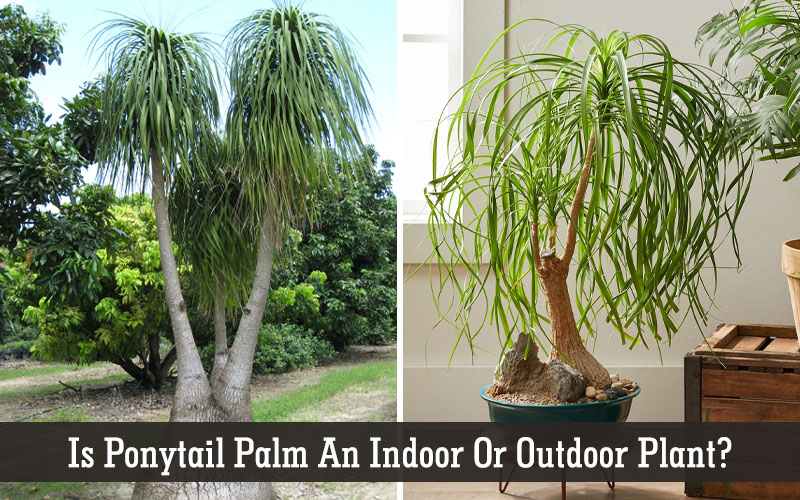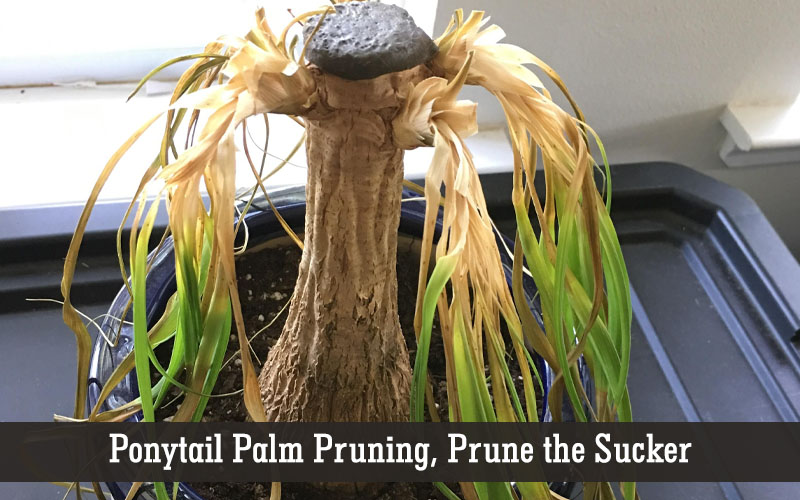The best thing about our ponytail palm care guide? It’s just so easy to follow.
It won’t be wrong to say ponytail palm is an ideal houseplant like the peperomia, which grows by itself with a little care. (Yes, it’s not an attention-seeker)
But the point to ponder is,
Is ponytail palm tree care difficult?

Want to know how to do it the easy way? You need to follow a few tips and instructions, and it’s off to a good start for its evergreen life. (Well, if you follow our guide)
Table of Contents
Is Ponytail Palm an Indoor or Outdoor Plant?
Before we proceed to enlighten you on how to care for ponytail palm, let’s clear your one confusion: Is it indoor or outdoor?
Is ponytail palm an indoor or outdoor plant?

It’s best to grow outdoors and can thrive perfectly indoors. All you need to do is pot a fast-draining succulent soil mix to avoid root rot and keep a check on watering habits.
Well, honestly, if we must say, it’s an all-rounder.
| Features | Outdoor | Indoor |
| Soil | Well-Drained (Loamy & Sandy)
Mixed-Soil (Cactus & Soil-Mix) |
Potting Mix (Succulent and Cacti) DIY (Equal parts of potting soil, perlite, and sand) |
| Temperature | 45°F – 70°F | Normal Room Temperature (60°-80°) |
| Watering | Once in 3-4 Weeks (Or less; feel the dryness of the soil) | Once in 2-3 Weeks (Don’t Overwater) |
| Light | Full Sun (8 hours) | Indirect Light (4-6 hours) |
| Weather | Summer | Winter (Best to avoid freezing temperatures) |
| Flowers | Takes Time (>5 years) | Very Rare (Once in a blue moon) |
| Tree Length | 20ft – 30ft | 3ft – 9ft |
How to take care of a ponytail palm?
It grows best in semi-dry conditions, loves indirect bright light, and is not a moisture fan. The ideal watering requirement is once in 2-3 weeks. Let the top two inches of soil dry before re-watering.
Get all the information here to do justice to the beauty and growth of your ponytail bonsai.
1. Planting

i. Soil
The best soil for ponytail palm?
Heavy soil is a big no-no! Prefer a well-drained soil mix usually used for succulents and cactus. DIY your own potting-soil mixture by combining equal parts of potting soil, perlite, and sand.
ii. Potting
You just bought a beautiful ponytail palm plant from the store, admiring the soothing vibe it gives off to your indoor. And, a thought crossed your mind,
How can you pot the plant yourself?
Take a clay-based pot (2 inches broader than the plant base) with a bottom-hole for easy drainage of excess water as ponytail palms don’t like wet soil. Put potting soil mix, and place your baby palm inside.
And, that’s it. Yes, really!
Remember to keep the bottom trunk part above the soil.
Opt for a small size heavy pot as these plants like to be crowded in their growing area. Trust us when we say these slow-growing plants can become giants as they grow.
iii. Temperature
What is the best indoor care temperature for my ponytail palm? You must have thought this once if you have this beautiful plant around you.
Yes, it can survive the average indoor temperature. It can be considered a cold-hardy (mature plant) if not placed for a prolonged time in low (15°F) environments. Ideal Temperature: 45°F – 70°F. Hardiness Zone: 9-12.
iv. Watering
The primary issue with the ponytail palm watering is that people just don’t know:
When is it over-watered? When is it under-watered?
So, How do you know when to water a palm plant?
‘Check the soil!‘ If the soil feels dry down to the plant’s root, it is the sign you must water it now. However, if there’s even a little wetness, leave it to dry. Ideal watering time: once in 2-3 weeks.
Give it the benefit of the doubt because neither you want to over-water it nor you want to leave it under-watered. Your lovely plant can survive weeks without water. Yes, you can say it has dry feelings for water.
v. Fertilizer
What’s the perfect time to fertilize?
The season of magic; Spring.
You can choose an organic chemical or liquid fertilizer to feed your ponytail palm plant. Whichever you prefer, dilute it to ½ strength.
How often should you fertilize your bonsai?
Liquid or chemical fertilizer(1/2 diluted), whichever you choose, the best is to fertilize once in the winter months and twice every month in the growing season. (Literally, they aren’t foodies at all)
vi. Repotting
This forgiving plant requires low maintenance (less-potting). Cut the bigger and damaged roots. Repot in a new container filled with potting mix, sand, perlite, vermiculite, and shredded bark. Size: larger the pot larger the size of the plant.
Repotting of a baby ponytail is slightly different than a large ponytail palm.
And, it can be quite a hassle if you’re dealing with a large-sized plant.
You don’t want to tire yourself out before the work is done. What to do then? How to cool it off? Get yourself a wearable cooler fan to finish off what you started.
Now that you’re ready. Let’s get it. (yes, it’s your ponytail palm’s voice, excited for its new home)
It’s not a rocket-science to repot a small ponytail palm tree. All you need is:
- A mess-free gardening mat (to put the soil)
- Pot, an inch or two larger than the existing one (if you want a bigger size)
- Or, the same size pot (if you want a smaller length)
- And the plant, of course
The requirements are similar for a large plant but with extra care, as they are heavy and difficult to deal with.
2. Growing

i. Speed of Growth
If you want to get a prosperous plant, place it in the potting soil mix, and let it grow independently.
It may grow 10-12 inches in a year or double in size after five years. However, the ponytail palm growth rate is much lower (yes, turtle-slow) indoors. Growth rate: 12-18ft tall and can spread to 10-15ft.
ii. Propagation of Ponytail Palm
The evergreen plant can self-reproduce with seeds, sister plants, pups, or offshoots.
Propagating new plants from existing plants is as easy as it may sound. (No? Well, trust us. It really is!)
Take a fast-draining container or pot and fill it with sand-based or cactus mix potting soil. Put the rooted end in the soil medium and cover it with a plastic bag. Lastly, place it in a warm area with moderate light.
Grow from offsets or pups:
- Remove the pup (ideally, 4 inches) base carefully from the parent plant.
- Position the offshoot or pup in the soil-mix set in a pot.
- Cover the pot with a plastic cover.
- Place in normal indoor temperature.
Grow from Seeds:
- There are times when offsets might not root, making seed propagation the only way.
- Seeds can germinate fast if the coating is slightly softened (Or soak overnight).
- Plant the seeds in a pot (3 inches) filled with gritty soil.
- Mist the soil and layer the top with some sand.
- Cover the pot with a plastic cover.
- Place the container at warm temperature (min 68°F).
3. Care / Training
Ponytail palm is a single stem plant, which means you have to train your plant to maintain the leaf’s greenery and beauty.
i. Trimming

Locate any wilted, brown, or yellow leaves. Use a clean scissor or snip to trim and preserve the beauty of the plant. It will allow the plant foliage to grow downward. The ideal time to train: Spring or Early Fall.
ii. Cutting
Should you cut the dead leaves? Yes! It refers to removing affected leaves or dark tips as these are delicate. Maintain an eye-level with the plant because you don’t want to turn a blind eye and cut the wrong part (healthy leaves).
iii. Pruning

Remove the woody material to restore or rejuvenate the plant. Use easy to trim pruning shears to shape the damaged leaves (brown, wilted) like a pro. The best time to prune is Fall and the growing season.
Prune The Sucker

- Suckers or child plants grow along with the main trunk of the parent plant
- They should be removed and grown separately. Otherwise, it gives a clumpy look to the base
- You can carve cuts (concave) into the base of the trunk (main trunk).
- Cut the sucker from the parent palm, plant it in the soil mix, and let it grow
Note: Place the carved plant in a comparatively dry environment. (to keep the cut safe from rotting)
4. Problems

Almost all the ponytail palm problems like brown, yellow, wilted, or dying leaves are the effects of over-watering the plant. Other reasons can be pests, under-watering, and over-fertilization.
Don’t over-water the plant, or it will end up with yellow leaves. Similarly, under-watering will leave crispy brown leaves. Remember to allow the soil to dry between watering sessions.
Here are the problems and solutions.
- The leaves of my ponytail palm are turning yellow
- The base of my ponytail palm is soft and mushy
- Leaves of palm ponytails are brown and wilted at the ends
Reason?
- Yellow leaves, soft and mushy plant base, and brown and wilted ends of the ponytail palm leaves are mainly due to, Over-Watering.
Solution?
- Stop watering your plant. It can go weeks without getting any water as it is a succulent. Allow the soil to dry between watering sessions. (once every 2-3 weeks is enough for your plant)
- Help! Tips of my ponytail bonsai are turning brown
Reason?
- If the leaves of your ponytail palm started to turn brown at the end, the reason could be under-watering, or they are Over-fertilized.
Solution?
- Brown tips on the leaves of ponytail palm signals it is over-fertilized. Best time to fertilize in Summer & Spring: once in 2-3 weeks. Winter & Fall: once in 4-6 weeks. Generally, once in 3-4 weeks.
- How do you know the tree is under-watered?
- Why my ponytail palm has brown leaves?
Reason?
- Ponytail palm plant loves to be in dry conditions (mostly). So, if you observe dry foliage, shriveled base, deplete roots or brown leaves, it is clearly the sign you are over-watering it.
Solution?
- Check the soil, put your finger into the mix and, if it sticks to your hand, it doesn’t need watering. Allow the soil (2-3 inches) to dry between watering sessions.
- What is wrong with my ponytail palm?
- What is the waxy white stuff on my plant?
- How can I treat a Scale on my ponytail palm plant?

Scale and spider mites are the primary pests that harm ponytail palms. Neem oil or water and dish soap solution can help get rid of both.
How to identify the spider mites? How can you tell the plant is under attack?
Small brown or red pinpoints on leaves or branches identify as the mites. The black or brown bumps (white waxy shell) indicate scales: yellow leaves and spider webs on the tips signal the plant is under pest-attack.
Solution?
- Spray neem oil
- Brush warm water and dish soap
Bottom Line
The slow-growing, low-maintenance, semi-dry environment plant, ponytail palm, is the best for people that love greenery but don’t want to put much effort into it.
You would agree with us. The pony palm tree is the ultimate houseplant for modern age people. (You got it right, the ‘always busy’ group)
Care of this amazing and lovely plant is generally simple; the most common difficulty one can have is to stop the usual ‘water-every-day’ habit and adapt to its ‘water-every-few-weeks’ needs!
That’s it from our side, gardening fellows!
Did we miss something?
Either way, let us know what new thing did you learn from our guide.

